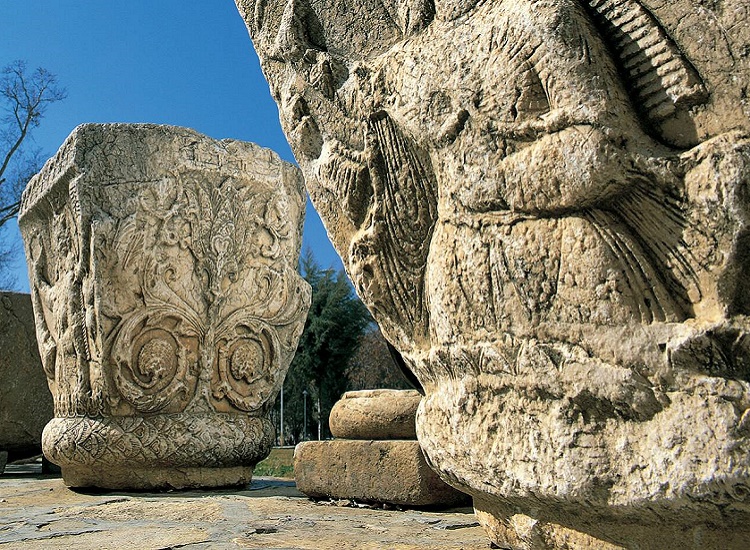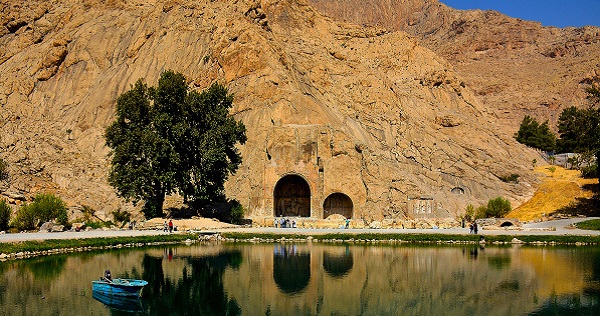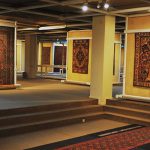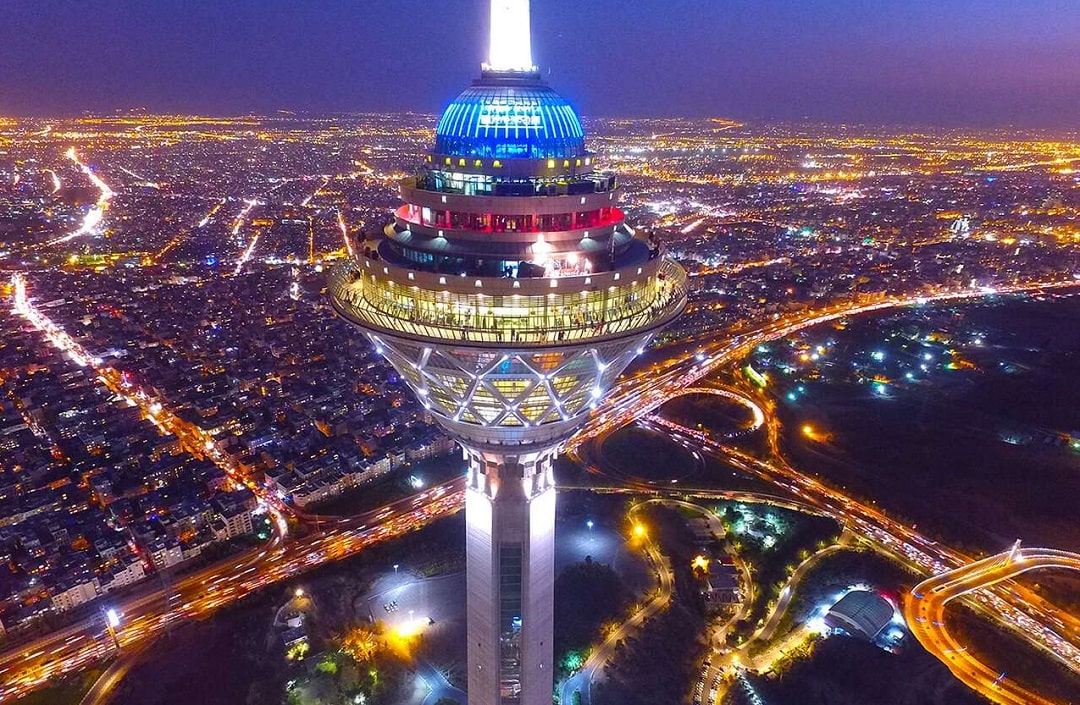
Taq-e Bostan | Glory of Sassanid Empire | Kermanshah, Iran
Fascinated by ancient Persian art? Then the 1700-year-old Taq-e Bostan should be on your visit list. This stunning memento of the glory of the Sassanid Empire is 5 km from Kermanshah city center. As one of the most famous historical sites of western Iran, Taq-e Bostan is a collection of rock reliefs, alcoves, and inscriptions left by powerful Persian Kings. On the face of a high rock in the middle of a scenic region, these powerful emperors have been showing off their glory, their royal luxuries, their religious beliefs, and their artistic abilities. Follow me on this blog to dig deeper into this amazing heritage.
Contents
- 1 Why Visit Taq-e Bostan
- 2 The Story of Taq-e Bostan
- 3 How Taq e Bostan Looks
- 4 The Relief of Ardeshir II – Tagh Bostan
- 5 Taq-e Bostan – The Small Alcove
- 6 Taq e Bostan – The Big Alcove
- 7 Taq e Bostan – The Hunting Episodes
- 8 Tagh Bostan – The Qajar Relief
- 9 Sassanid Fashion at Taq e Bostan
- 10 An Inspiration for the Portrait of Zoroaster
- 11 Taq e Bostan Under Attack
- 12 Taq e Bostan as an Archeological Park
- 13 More About Taq-e Bostan
- 14 Like to visit Taq-e Bostan?
- 15 Taq-e Bostan Tours
- 16 Taq e Bostan on Map

Taq-e Bostan and the charming pond in front of it
Why Visit Taq-e Bostan
- Taq-e Bostan is a priceless heritage from the great Sassanid Empire
- It showcases ancient Persian art
- The reliefs depict royal entertainments and luxuries
- The pictures feature the special fashion of the era
- You can find an interesting archeological museum beside it

A front view of Taq-e Bostan
The Story of Taq-e Bostan
More than 2000 years ago, Taq-e Bostan was the royal hunting grounds of Parthian kings. But around 1700 years ago, Sassanid kings rose to power and left their own mark on the place. Originally, they chose the mountains near Persepolis as perfect places to show off their grandeur. But later Sassanid kings saw the Silk Road, the busy road that connected the eastern and western parts of the ancient world together, a better place.
So, the face of a high cliff on the Silk Road became the site where Ardeshir II ordered bas reliefs that depict his coronation ceremony. Then Khosrow II added a large alcove that has become the most stunning part of this ancient heritage. Shapur III also added another smaller alcove and bas relief showing himself and his grandfather. 1300 years later, a self-glorifying Qajar-era governor of Kermanshah added another rock relief to the large alcove. Today, Taq-e Bostan has become one of the most precious mementos of the glory of ancient Persia and a top tourist attraction in the west of Iran.

An 1840 painting of Taq-e Bostan by Eugene Flandin
How Taq e Bostan Looks
Taq e Bostan is home to 3 main parts:
- The Relief of Aredeshir II
- The Big Alcove
- The Small Alcove
- The reliefs associated with the two alcoves
- The Relief of Mohammad Ali Mirza

A distant view of Taq e Bostan – Tagh Bostan
The Relief of Ardeshir II – Tagh Bostan
On the right side of the smaller alcove, you can see the oldest part of Taq-e Bostan. It is a rock relief that shows the coronation ceremony of Ardashir II. The relief panel is almost 4.07 meters wide and 3.9 meters high. On the relief, you can see another figure giving Ardashir the ring of royal power. This figure is either Shapur II (the previous king), or Ahura Mazda (the Zoroastrian God). Behind him, on the left, a figure of Zarathustra (ancient prophet of Iran) or Mithra (god of light) is standing on a lotus flower and witnessing the coronation. To show the Sassanid victory over the Roman Emperor, Julian, the captive Julian is also pictured under the Persian king’s feet.

The Relief of Ardashir II – Taq e Bostan
Taq-e Bostan – The Small Alcove
The smaller alcove on Taq-e Bostan is between the Relief of Ardashir II and the Big Alcove. It is 5.80 meters wide and 5.30 meters high. Probably built by Shapur III, the smaller alcove includes a relief depicting Shapur the Great and his son Shapur III facing each other. On top of them are two inscriptions in Middle Persian. Shapur II (on the right) and Shapur III (on the left), have their hands on a long sword. To the right of the alcove, you can see another relief showing Shapur II. He is stomping the Roman emperor Julian the Apostate and receiving a crown of blessing from Zoroastrian god.

The Small Alcove (on the left) – Taghe Bostan
Taq e Bostan – The Big Alcove
Also known as the Iwan of Khosrow, the bigger alcove showcases reliefs on both sides and on the back wall. On the side walls, you can see elephant-mounted hunting scenes. But the back wall features the coronation of Khosrow II. The three figures on the coronation scene are probably Khosrow II (in the middle), Ahura Mazda (Zoroastrian God), and Anahita (goddess of water). Ahura Mazda is giving Khosrow the crown of royal power. Beneath the coronation scene, you can find Khosrow riding off on his favorite horse in full armor. He is clad as what looks like a Medieval Persian knight. The front of the alcove is bordered with reliefs that show happiness and celebration. Among them, you can see winged angels, trees of life, hunting scenes, fish, elephants, and horses.

A View of the Taq-e Bostan Big Alcove
Taq e Bostan – The Hunting Episodes
On the right and left walls of the big alcove, there are pictures of different episodes of the royal hunt. From the beginning of the Achaemenid Empire to the end of the Sassanid Empire, hunting was a favorite royal activity. That’s why hunting scenes appear frequently with coronation scenes. These scenes are among the most vivid and narrative stone carvings from the classical world. On one of these boar and deer hunting reliefs, 5 elephants are directing boars toward the king. The king is standing with a bow and arrow in his hand and female musicians are entertaining him. In another scene, a boat carries female harpists and the king is shown as having hunted two large boars.

An episode of the royal hunt on Taq-e Bostan
Tagh Bostan – The Qajar Relief
On the left wall of the big alcove, you can see a colored relief that is different from the rest. Known as the Relief of Mohammad Ali Mirza or Dowlatshah relief, this part was added to the Big Alcove in the 19th century. It was the self-glorifying Qajar-era governor of Kermanshah who felt so grand to allow himself to carve on this historical heritage. The tragic part is that he did it without good taste and sort of disturbed the harmony of the site.

The Qajar relief on Taq e Bostan
Sassanid Fashion at Taq e Bostan
Sassanid fashion is one of the first things that attract your attention when you have your eyes on Taq-e Bostan. The kings, deities, courtiers, and captives on the rock reliefs have their own special clothes and accessories. The hunting clothes have geometrical designs and golden threads. The rowers’ clothes also have dramatic designs on them. Pictures of the mythical Iranian bird, Simurgh, are also on the hunting clothes of Khosrow. With long bushy hair and a beard, he is also wearing a necklace, bracelet, and earnings. What is interesting is the similarities between the way the king and Ahura Mazda are dressed. They are both wearing pleated pants that are tied to their ankles with a piece of the band. They are both wearing a belt and a bracelet as well. On the small alcove, the Shapurs are wearing loose pants, necklaces, curled hair, and pointed beards that are tucked in a ring.

The Special Sassanid Clothing showcased on Taq-e Bostan
An Inspiration for the Portrait of Zoroaster
From the efforts of different artists to visualize Zoroaster, the ancient prophet of Persia, one was inspired by Taq-e Bostan. The artist that created this portrait was mistaken by the common belief of the time that the figure standing next to the king is Zoroaster. But today, the figure is now identified as Mithra (god of light).
Taq e Bostan Under Attack
Taq-e Bostan was looted and damaged several times throughout history. Word has it that a carpet made of precious jewels used to carpet Taq-e Bostan. But during the Arab Conquest of Persia, Arab commanders looted the place and divided the carpet among themselves. English and Stalin’s army also caused damage to the historical site.

The Remains of Taq e Bostan
Taq e Bostan as an Archeological Park
To the north of Taq-e Bostan Boulevard, there is a museum that houses a collection of rocks and pillars from the late Sassanid and Islamic eras. The pillars showcase designs like Persian deities, lotus flowers, trees of life, and royal figures. Some remnants of a Qajar-era palace also take up a part of the museum. A Sassanid-era coffin and pillars from a Sassanid palace that was never built are also interesting relics treasured in the museum.

Pillars at Taq-e Bostan Museum
More About Taq-e Bostan
Visit Hours
8 a.m. to 8 p.m.
Visit days
All days except some public holidays
The Best Time to Visit Taq-e Bostan
The elegant Taq-e Bostan is in a lovely area. The most charming element in the beautiful harmony of the place is the gorgeous pond at the base of the cliff. Sacred springs flow into the pond and create a pleasant view together with the trees, and the historical cliff. This makes the site worth a visit in every season and any time during the day. Yet the most striking time to visit the site is in the evening. In the golden light of the sunset, the cliff turns a brilliant orange that gives it a striking glory. Then the lights turn on and bring a different atmosphere to the historical place.

Taq-e Bostan at Night
What to Do Nearby
If you go to Taq-e Bostan, don’t miss the super popular roast ribs. Kermanshah is famous for its delicious roast ribs and the restaurants around the historical site serve this local delicacy.
The Nearby Attractions
Beside Taq-e Bostan, you can check out sites from prehistoric and historical periods of Iran. Places like the new-found Morad-Hassel Tepe, an ancient village, a Parthian graveyard, and a Sassanid hunting ground. Plus,
Where to Eat Nearby
The Restaurant at Hotel Jamshid
Shandiz Sarsabz Restaurant
Bishe Restaurant
Like to visit Taq-e Bostan?
Then hop on our Heritage of the Sassanid Empire tour, our Kermanshah City Tour, or our 16-day Deep into the Heart of Persia tour.
Taq-e Bostan Tours
Taq e Bostan on Map
Keywords: Taq-e Bostan Photos, Taq i Bustan, Taq Bostan











